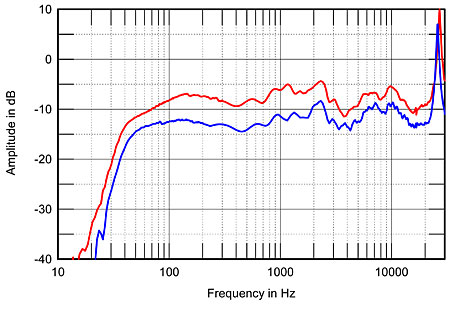| Columns Retired Columns & Blogs |
Totem Acoustic Model 1 loudspeaker 2008 Measurements
Sidebar: 2008 Measurements
The Model 1 Signature's sensitivity was a little higher than that of the original, at an estimated 86.5dB(B)/2.83/m, which is within experimental error of the specified 87dB. Its impedance (not shown) was identical to the earlier speaker's, with a minimum value of 3.8 ohms between 200 and 300Hz and a rising trend through the midrange and treble. The Totem won't be too difficult for a good amplifier to drive. The small, well-braced cabinet did have a strong vibrational mode evident at 675Hz on all surfaces, but this is high enough in frequency not to have audible effects. Through a stethoscope placed on the top panel I could hear the decay of two lower-level modes, at 290 and 320Hz, when I paused the CD player. I wonder if these were connected with the lower-midrange warmth I occasionally noted on piano.

Fig.1 Totem Model 1 Signature, acoustic crossover on tweeter axis at 50", corrected for microphone response, with the nearfield responses of the woofer and port, plotted in the ratio of the square roots of their radiating areas below 300Hz and 1kHz, respectively.
Fig.1 shows the individual responses of the tweeter, woofer, and port. Though the aluminum-dome tweeter has a huge resonant peak visible at 27kHz, this is high enough in frequency not to mess with the speaker's sound quality, certainly not with CD playback. (CD-sourced audio signals contain no energy above 22kHz to excite this resonance.) The crossover to the woofer features asymmetric filter slopes with what appears to be a third-order roll-in for the tweeter, but a much sharper rolloff for the woofer. The woofer's minimum-motion notch, due to the back pressure from the reflex-port resonance holding the cone stationary, lies at 42Hz, the lowest note of the acoustic and electric basses' E string—which is what I'd expected from the impedance measurement. The port itself has a classic bandpass output centered on the same frequency, although, as with the original Model 1, a couple of pipe resonances disturb its output in the midrange.

Fig.2 Totem Model 1 Signature, anechoic response on listening axis at 50", averaged across 30° horizontal window and corrected for microphone response, with the complex sum of the individual responses plotted below 300Hz (red); similar plot of the 1992 sample of the Totem Model 1 taken under identical conditions (blue), offset by 3dB for clarity.
The red trace in fig.2 is the Model 1 Signature's response averaged across a 30° horizontal window on the tweeter axis, spliced at 300Hz to the complex sum of the nearfield woofer and port responses. The blue trace, retrieved from my measurement archives, is the response of our 1992 sample of the Model 1, taken under identical conditions (other than the fact that, in 1992, we were based in 7000'-high Santa Fe, New Mexico, rather than in sea-level New York City). It is a tribute to Totem's consistency of manufacture that, despite the changes in parts and suppliers, this is obviously the same loudspeaker. A feature to note in this graph is the prominence in the upper midrange, which, all else being equal, will aid the speaker's presentation of recorded detail while perhaps flattening soundstage depth a little.

Fig.3 Totem Model 1 Signature, lateral response family at 50", normalized to response on tweeter axis, from back to front: differences in response 90–5° off axis, reference response, differences in response 5–90° off axis.
The step in the response at the top of the woofer's passband might add a little nasality to the Totem's sound, though I heard none. The Model 1 Signature's lateral-dispersion plot (fig.3) does reveal a slight off-axis flare in the region immediately above the on-axis step that might reduce the step's audibility. The contour lines in this graph are otherwise smooth and evenly spaced, which correlates with the Totems' stable, accurate stereo imaging.
Fig.4 Totem Model 1 Signature, 1/6-octave, spatially averaged response in JA's listening room.
Fig.4 shows how these anechoic behaviors added up in my listening room. This graph was produced by averaging 40 responses taken for each speaker individually in a vertical horizontal grid centered on the position of my ears in my listening chair. The spatial averaging minimizes position-dependent room effects, while the measurement integrates the speaker's on- and off-axis behaviors in a manner that has proved in the past to correlate quite well with what is heard. The response trend is generally smooth, though a rise is apparent throughout the midrange. The off-axis flare at the bottom of the tweeter's passband doesn't completely smooth out the step in the on-axis response, but it does reduce its severity. Despite my feeling that the Totem could sound a bit mellow, there is actually plenty of energy present in-room in the top two audio octaves. The bass is shelved down, but the rate of rolloff is not as severe as I might have expected; in the positions the Totems ended up in, they were definitely getting some low-frequency reinforcement from my room's sidewalls.
Finally, the Totem's cumulative spectral-decay plot on the tweeter axis (not shown) was a little cleaner than that of the original, with slightly less delayed energy evident at the frequency of the low-treble response step. The region covered by the tweeter was very clean.—John Atkinson
- Log in or register to post comments




































